 |
 |
| Home | Welcome | What's New | Site Map | Glossary | Weather Doctor Amazon Store | Book Store | Accolades | Email Us |
 | |||||||||
Weather Almanac for June 2004SLOSHING THE LAKES: THE SEICHEWhen I was young, a favourite summer activity was playing in the bathtub or the small inflatable pool with my toy boats. I often gave them "rough seas" by sliding from one end of the tub/pool to the other, thus causing an end-to-end slosh of the enclosed water body. Little did I realize that similar slosh waves formed in nearby Lake Michigan. (I since have had to relinquish this play, today's much smaller bathtubs and my much bigger size preclude such personal motion in a tub; however, the simple act of getting out of the tub also causes a tub slosh.) During my youth, I at times heard the television weathercaster relay a seiche warning for boaters and fishermen along the western shore of Lake Michigan. One in particular turned deadly along the Chicago lakefront. It would be more than a decade, however, before I really knew what a seiche was. In basic terms, a seiche is a standing wave forming in an enclosed or partly enclosed body of water by strong winds, atmospheric pressure jumps, landslides or distant earthquakes. Seiches produce regular, periodic fluctuations of lake waters as the standing waves race between opposing shores within the lake basin, diminishing in height with each transit, like those sloshing waves I produced in the bathtub. Swiss scientist Francois-Alphonse Forel first coined the term (from a French word meaning "to sway back and forth") while studying the rhythmic water oscillations of Lake Geneva in the late nineteenth century. In 1955, Anders Kvale described similar oscillations of lake levels in Norway and England caused by the 1950 earthquake at Assam, India as seismic seiches. Similar sloshes are often observed in swimming pools in response to earthquakes. My interest here, however, focuses on weather-induced seiches, particularly those on large enclosed lakes, though they can occur in partially-enclosed arms of the sea such as bays, fjords and harbours. 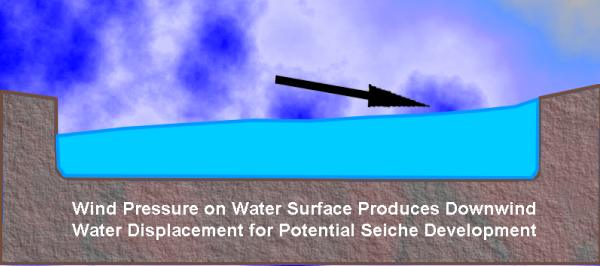 Seiches are caused by atmospheric disturbances passing over the waters of the lake. Most often, persistent strong winds blowing along the lake axis initiate their formation when they cease blowing, but a fast-moving squall line with a strong pressure jumps and downdraft winds can also induce a seiche as it passes over a lake. (Seiches should not be confused with storm surges that form when lake waters are blown toward and pile up on the shore but do not slosh between the opposing shores.) In either case, surface waters are pushed to the downwind lakeshore. When the winds die or the squall line passes, the water accumulated along the downwind coast flows back across the basin and begins sloshing within the lake. This causes rising and falling water levels on both sides of the basin. With each circuit, the seiche diminishes in height eventually damping out into the background lake motions. Like the striking of a bell, it takes only one disturbance event to begin the wave action of a seiche. Once begun, a seiche can continue for days after the forces that created it cease. Multiple seiches may arise when strong winds pulse over a lake or when a series of squall lines moves across the waters. Strong winds frequently produce seiches on large lakes, but most are rather small in size — less than 30 cm (a foot) high — and go unnoticed amidst the general surface wave motions. However, during severe storm conditions, water-level differences greater than 5 metres (16 feet) have been observed between opposing lakeshores. Large seiches (i.e, greater than one metre (3 ft)) occur in the Great Lakes basin every year, usually from May to September. The Great Lake most affected by seiches is Lake Erie because it is the shallowest and its basin is often aligned with storm wind directions. One passing storm set up a seiche in 1979 that resulted in a water-level difference of 4.3 metres (14 feet) between Toledo and Buffalo. The standing wave of a seiche can take a number of forms, determined primarily by the number of nodes in the standing wave. (Of course, this is the idealized textbook situation, and the complexity of the lake basin topography plays a major role in the form of any real-world seiche.) A node in an oscillating wave system is marked by little or no vertical oscillating motions, a point where travelling waves moving in opposite directions cancel each other. In contrast, the antinodes are the points in the basin with the greatest vertical motion. The simplest seiche configuration has one node located at the centre of the basin and two antinodes (a seiche with modality of one). One antinode is the wave peak or crest when the other is the wave trough. In the simple diagram below, at one instant, the left antinode is the peak while the right one is at the trough. After half an oscillation, the positions of peak and trough will be reversed. 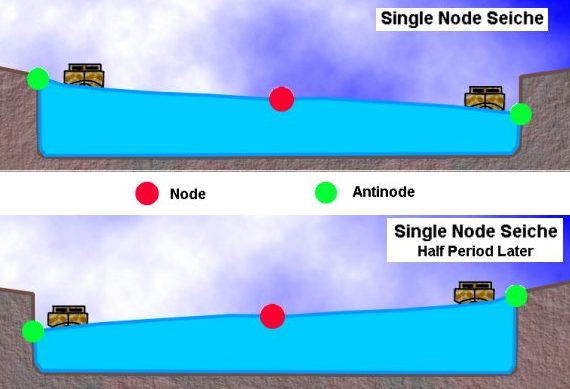 Changes in lake level during a single node seiche.A seiche may have many nodes, in theory an infinite number but in reality rarely more than a handful. In a two-node seiche, the antinodes will be found at the shores and the center of the basin with nodes halfway between the shore and center points. With the two-node seiche, the shoreline antinodes are in synch, either rising or falling together, and the mid-lake antinode is in opposition, cresting when shore antinodes are in trough, and troughing when shore antinodes crest. In general, the fewer the nodes and shallower the basin, the more pronounced the difference in water levels between crest and trough. 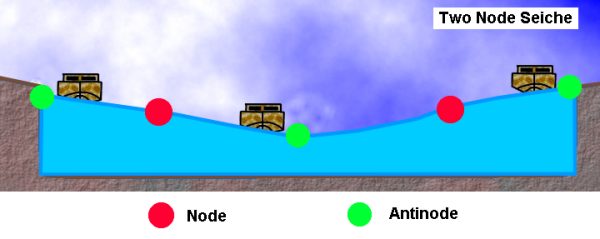 Changes in lake level during a two-node seiche.Lakes usually have characteristic periods of oscillation, related to the water depth, number of nodes and the cross-basin distance over which the seiche moves. On the Great Lakes the period between seiche peaks ranges from minutes to more than eight hours, depending on the location where the seiche forms. The typical seiche across Lake Erie has a period of around 14 hours. For other lakes, the period is shorter, for example, in Lake Champlain in upstate New York, 4 hours; Scotland's Loch Ness, about 30 minutes. 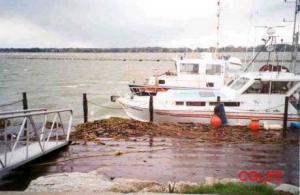 Seiche debris on the Black Rock Canal at the mouth of the Niagara River |
|||||||||
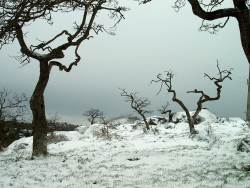 |
To Purchase Notecard, |
Now Available! Order Today! | |
 |
 |
NEW! Now |
The BC Weather Book: |


